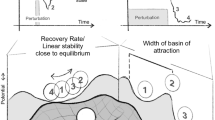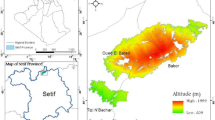Abstract
Physical principles governing passive microwave remote sensing of hydrological variables are outlined and illustrated by actual observations by ground-based, air-borne and space-borne microwave radiometers operating at different frequencies. Specific hydrological variables addressed in this paper are soil moisture, seasonal inundation of rivers and swamps, vegetation, snow, and rainfall. Passive remote sensing provides measurements of electromagnetic radiation emitted by the land-atmosphere system, which can be related more directly to the radiative characteristics of the system than to physical or physiological characteristics. Estimation of hydrological variables from microwave observations necessarily involves models relating the radiative to the physical characteristics, and in general more than one physical characteristics determine the microwave observations. This non-uniqueness in the relationship between microwave observations to a particular hydrological variable leads to uncertainties in the estimation of the variable. Notwithstanding this limitation, the principles and the examples given in this paper illustrate the value of passive microwave observations to regional and global hydrology at a temporal resolution of days aggregated to a decade.
Similar content being viewed by others
References
Alho, C. J. R., Lacher, J. R., Lacher, T. E., and Goncalves, H. C.: 1988, ‘Environmental Degradation in the Pantanal Ecosystem’,BioScience 38, 164–171.
Allison, L. J., Schmugge, T. J., and Byrne, G.: 1979, ‘A Hydrologic Analysis of East Australian Floods Using Nimbus-5 Electrically Scanning Radiometer Data’,Bulletin of the American Meteorological Society 60, 1414–1427.
Asrar, G.: 1989,Theory and Applications of Optical Remote Sensing, John Wiley, New York.
Blanchard, G. J., McFarland, M. J., Schmugge, T. J., and Rhoades, E.: 1981, ‘Estimation of Soil Moisture with API Algorithms and Microwave Emission’,Water Resources Bulletin 17, 767–774.
Budyko, M. I.: 1986,The Evolution of the Biosphere, Kluwer Acad. Publ. Boston.
Camillo, P. and Schmugge, T. J.: 1983, ‘Estimating Soil Moisture Storage in the Root Zone from Surface Measurements’Soil Science 135, 245–264.
Chandrasekhar, S.: 1960, Radiative Transfer, Dover, New York.
Chang, A. T. C., Foster, J. L., Hall, D. K., Rango, A. and Hartline, B. K.: 1982, ‘Snow Water Equivalent Estimation by Microwave Radiometry’,Cold Regions Science and Technology 5, 259–267.
Chang, A. T. C., Foster, J. L., and Hall, D. K.: 1987, ‘Nimbus-7 SMMR Derived Global Snow Cover Parameters’,Annals of Glaciology 9, 39–55.
Chang, A. T. C., Foster, J. L., and Hall, D. K.: 1990, ‘Satellite Sensor Estimates of Northern Hemisphere Snow Volume’,International Journal of Remote Sensing 11, 167–171.
Choudhury, B. J.: 1989, ‘Relating Nimbus-7 37 GHz Data to Land Surface Evaporation’,Proc. International Association of Hydrological Sciences 186, 59–66.
Choudhury, B. J. and Blanchard, B. J.: 1983, ‘Simulating Soil Water Recession Coefficients for Agricultural Watersheds’,Water Resources Bulletin 19, 241–248.
Choudhury, B. J. and Golus, R. E.: 1988, ‘Estimating Soil Wetness Using Satellite Data’,International Journal of Remote Sensing 9, 1251–1257.
Choudhury, B. J. and Monteith, J. L.: 1988, ‘A Four-layer Model for the Heat Budget of Homogeneous Land Surfaces’,Quarterly Journal of the Royal Meteorological Society 114, 373–398.
Choudhury, B. J., Schmugge, T. J., Newton, R. W., and Chang, A.: 1979, ‘Effect of Surface Roughness on Microwave Emission from Soils’,Journal of Geophysical Research 84, 5699–5706.
Choudhury, B. J., Wang, J. R., Hsu, A. Y., and Chien, Y. L.: 1990, ‘Simulated and Observed 37 GHz Emission over Africa’,International Journal of Remote Sensing 11.
Eagleson, P. S.: 1982, ‘Ecological Optimality in Water-Limited Natural Soil-Vegetation Systems. I. Theory and Hypothesis’,Water Resources Research 18, 325–340.
Famiglietti, J. S. and Wood, E.: 1990, ‘Evapotranspiration and Runoff from Large Land Areas: Land Surface Hydrology for Atmospheric General Circulation’,Surveys in Geophysics 12, 179–204 (this issue).
Giddings, L. and Choudhury, B. J.: 1989, ‘Observation of Hydrological Features with Nimbus-7 37 GHz Data, Applied to South America’,International Journal of Remote Sensing 10, 1673–1686.
Hollinger, J., Lo, R., Poe, G., Savage, R., and Pierce, J.: 1987,Special Sensor Microwave Imager User's Guide, Naval Research Laboratory, Washington, D.C.
Jasinski, M. F. and Eagleson, P. S.: 1990, ‘Estimation of Subpixel Vegetation Cover Using Red Infrared Scattergrams’,IEEE Transections on Geoscience and Remote Sensing 28, 253–267.
Kunzi, K. F., Patil, S., and Rott, H.: 1982, ‘Snowcover Parameters Retrieved from Nimbus-7 Scanning Multichannel Microwave Radiometer (SMMR) Data’,IEEE Transactions on Geoscience and Remote Sensing GE-20, 452–467.
Mo, T., Choudhury, B. J., Schmugge, T. J., Wang, J. R., and Jackson, T. J.: 1982, ‘A Model for Microwave Emission from Vegetation-Covered Fields’,Journal of Geophysical Research 87, 11229–11237.
Negri, A. J., Adler, R. F., and Kummerow, C. D.: 1989, ‘False-Color Display of Special Sensor Microwave Imager Data’,Bull. Am. Meteorl. Soc. 70, 146–151.
Schmugge, T. J.: 1985, ‘Remote Sensing of Soil Moisture’, in M. G. Anderson and T. P. Burt (eds.),Hydrologic Forecasting, John Wiley, New York, pp. 101–124.
Shin, K. S., Riba, P. E., and North, G. N.: 1990, ‘Estimation of Area Time Averaged Rainfall over Tropical Oceans from Microwave Radiometry’J. Clim. App. Met. (in press).
Spencer, R. W., Coodman, J. M., and Hood, R. E.: 1989, ‘Precipitation Retrieval over Land and Ocean with the SSMI: Identification and Characteristics of the Scattering Signal’,Journal of Atmospheric and Oceanic Technology 6, 254–273.
Tanner, C. B. and Sinclair, T. R.: 1983, ‘Efficient Water Use in Crop Production: Research or Research? in H. M. Taylor, W. R. Jordan and T. R. Sinclair (eds.)Limitations to Efficient Water Use in Crop Production, American Society of Agronomy, Madison, Wisconsin, pp. 1–28.
Ulaby, F. T., Batlivala, P. P., and Dobson, M. C.: 1978, ‘Microwave Backscatter Dependence on Surface roughness, Soil Moisture, and soil Texture: Part I, Bare Soil’,IEEE Transaction on Geoscience and Electronics GE-16, 286–295.
Ulaby, F. T., Bradley, G. A., and Dobson, M. C.: 1979, ‘Microwave Backscatter Dependence on Surface Roughness, Soil Moisture, and Soil Texture: Part II, Vegetation-Covered Soil’,IEEE Transactions on Geoscience and Electronics GE-17, 33–40.
Ulaby, F. T., Moore, R. K., and Fung, A. K.: 1982,Microwave Remote Sensing, Vol. II, Addision-Wesley, Massachusetts.
Verma, S. B., Baldocchi, D. D., Anderson, D. E., Matt, D. R., and Clement, R. J.: 1986, ‘Eddy Fluxes of CO2, Water Vapor, and Sensible Heat over a Deciduous Forest’,Boundary-Layer Meteorology 36, 71–91.
Wang, J. R.: 1985, ‘Effect of Vegetation on Soil Moisture Sensing Observed from Orbiting Microwave Radiometers’,Remote Sensing of Environment 17, 141–151.
Wang, J. R.: 1987, ‘Microwave Emission from Smooth Bare Fields and Soil Moisture Sampling Depths,IEEE Transactions on Geoscience and Remote Sensing GE-25, 616–622.
Wang, J. R. and Choudhury, B. J.: 1981, ‘Remote Sensing of Soil Moisture Content over Bare Fields at 1.4 GHz Frequency’,Journal of Geophysical Research, 5277–5282.
Wilheit, T. T., Chang, A. T. C., Rao, M. S. V., Rodgers, E. B., and Theon, J. S.: 1977, ‘A Satellite Technique for Quantitatively Mapping Rainfall Rates over the Oceans’,Journal of Applied Meteorology 16, 551–560.
Wilheit, T. T., Chang, A. T. C., and Chiu, L. S.: 1990, ‘Retrieval of Monthly Rainfall Indices from Microwave Radiometric Measurements Using Probability Distribution Function’,J. Atmos. Ocean Tech. (in press).
Wong, C. S. and Dunin, F. X.: 1987, ‘Photosynthesis Transpiration of Trees in a Eucalypt Forest Stand: CO2, Light and Humidity Responses’,Australian Journal of Plant Physiology 14, 619–632.
Author information
Authors and Affiliations
Rights and permissions
About this article
Cite this article
Choudhury, B.J. Passive microwave remote sensing contribution to hydrological variables. Surv Geophys 12, 63–84 (1991). https://doi.org/10.1007/BF01903412
Issue Date:
DOI: https://doi.org/10.1007/BF01903412




